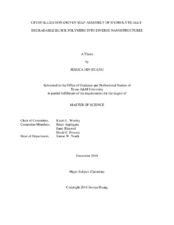| dc.description.abstract | Cysteine-functionalized poly(L-lactide)-block-polycarbonates (PLLA-b-PC-cys) were synthesized and assembled in nanopure water, by crystallization-driven self-assembly (CDSA), to yield a variety of nanostructures, of which the dimensions were determined by the polymer composition. CDSA exploits crystallization of one segment of a block polymer to trap nanoscale morphologies that are inaccessible by solution-state self-assembly. This project expands the scope of CDSA-mediated block polymer nanostructures by the design, synthesis, and assembly of fully-degradable PLLA-b-PC, in which the semi-crystalline polylactide block enables CDSA and the polycarbonate block contains alkyne groups for post-polymerization modification. Installation of zwitterionic cysteine moieties onto the polycarbonate alkynes rendered the block polymers amphiphilic. CDSA was performed in nanopure water, by heating above the Tvg of the PLLA block and cooling to induce assembly. The morphology of the resulting nanostructures was investigated as a function of block length and ratio by atomic force microscopy (AFM).
These studies demonstrated that spherical, cylindrical, or platelet-like morphologies could be generated, depending on the ratio of the hydrophobic block to the hydrophilic block. Polymers with hydrophobic weight percentages lower than 30% formed only spheres, while assembly of those with intermediate weight percentages (34% and 36%) resulted in platelets with lengths of ca. 500 nm. Finally, polymers with the highest weight percentages (42% and 71%) yielded large bundles of cylinders, ca. 500 nm or longer.
Reproducible assembly of a fully-degradable polymeric system is a significant step towards drug delivery applications. The polymer assemblies described in this thesis are currently under investigation as tunable delivery vehicles for silver antimicrobials to treat recurrent urinary tract infection (UTI). | en |


